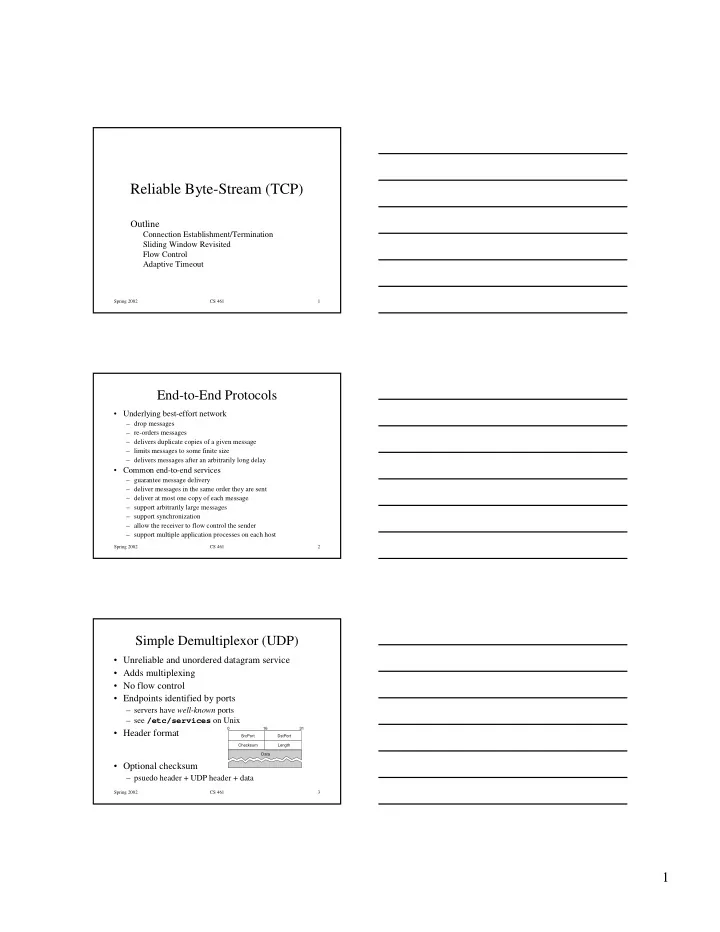

Reliable�Byte-Stream�(TCP) Outline Connection�Establishment/Termination Sliding�Window�Revisited� Flow�Control Adaptive�Timeout Spring�2002 CS�461 1 End-to-End�Protocols • Underlying�best-effort�network – drop�messages – re-orders�messages – delivers�duplicate�copies�of�a�given�message – limits�messages�to�some�finite�size – delivers�messages�after�an�arbitrarily�long�delay • Common�end-to-end�services – guarantee�message�delivery – deliver�messages�in�the�same�order�they�are�sent – deliver�at�most�one�copy�of�each�message – support�arbitrarily�large�messages – support�synchronization – allow�the�receiver�to�flow�control�the�sender – support�multiple�application�processes�on�each�host Spring�2002 CS�461 2 Simple�Demultiplexor�(UDP) • Unreliable�and�unordered�datagram�service • Adds�multiplexing • No�flow�control • Endpoints�identified�by�ports – servers�have� well-known ports – see� /etc/services on�Unix 0 16 31 • Header�format SrcPort DstPort Checksum Length Data • Optional�checksum – psuedo�header�+�UDP�header�+�data Spring�2002 CS�461 3 1
TCP�Overview • Connection-oriented • Full�duplex • Byte-stream • Flow�control:�keep�sender� from�overrunning�receiver – app�writes�bytes – TCP�sends� segments • Congestion�control:�keep� – app�reads�bytes sender�from�overrunning� network Application�process Application�process Write Read … bytes … bytes TCP TCP Send�buffer Receive�buffer … Segment Segment Segment Transmit�segments Spring�2002 CS�461 4 Data�Link�Versus�Transport • Potentially�connects�many�different�hosts – need�explicit�connection�establishment�and�termination� • Potentially�different�RTT – need�adaptive�timeout�mechanism • Potentially�long�delay�in�network – need�to�be�prepared�for�arrival�of�very�old�packets • Potentially�different�capacity�at�destination� – need�to�accommodate�different�node�capacity • Potentially�different�network�capacity – need�to�be�prepared�for�network�congestion Spring�2002 CS�461 5 Segment�Format 0 4 10 16 31 SrcPort DstPort SequenceNum Acknowledgment HdrLen 0 Flags AdvertisedWindow Checksum UrgPtr Options�(variable) Data Spring�2002 CS�461 6 2
Segment�Format�(cont) • Each�connection�identified�with�4-tuple: – (SrcPort,�SrcIPAddr,�DsrPort,�DstIPAddr) • Sliding�window�+�flow�control – acknowledgment,�SequenceNum,�AdvertisedWinow Data� (SequenceNum) Sender Receiver Acknowledgment�+ AdvertisedWindow • Flags – SYN,�FIN,�RESET,�PUSH,�URG,�ACK • Checksum – pseudo�header�+�TCP�header�+�data Spring�2002 CS�461 7 Connection�Establishment�and� Termination Active�participant Passive�participant (client) (server) SYN,�SequenceNum�=�x � y , � = m N u e n c e 1 q u + � e x S = � K , � t � C n A m e + � g N � d Y l e S w n o k A c ACK,�Acknowledgment�=�y +�1 Spring�2002 CS�461 8 State�Transition�Diagram CLOSED Active�open/SYN Passive�open Close Close LISTEN SYN/SYN�+�ACK Send/SYN SYN/SYN�+�ACK SYN_RCVD SYN_SENT ACK SYN�+�ACK/ACK Close/FIN ESTABLISHED Close/FIN FIN/ACK FIN_WAIT_1 CLOSE_WAIT FIN/ACK ACK�+�FIN/ACK ACK Close/FIN FIN_WAIT_2 CLOSING LAST_ACK Timeout�after�two� ACK ACK segment�lifetimes FIN/ACK TIME_WAIT CLOSED Spring�2002 CS�461 9 3
Sliding�Window�Revisited Sending�application Receiving�application TCP TCP LastByteWritten LastByteRead LastByteAcked LastByteSent NextByteExpected LastByteRcvd • Sending�side • Receiving�side – LastByteAcked <�= – LastByteRead <� LastByteSent NextByteExpected – LastByteSent <�= – NextByteExpected <�= LastByteWritten LastByteRcvd�+1 – buffer�bytes�between� – buffer�bytes�between� LastByteAcked and� NextByteRead and� LastByteWritten LastByteRcvd Spring�2002 CS�461 10 Flow�Control • Send�buffer�size:� MaxSendBuffer • Receive�buffer�size:� MaxRcvBuffer • Receiving�side – LastByteRcvd - LastByteRead <�=� MaxRcvBuffer – AdvertisedWindow =� MaxRcvBuffer - ( NextByteExpected - NextByteRead ) • Sending�side – LastByteSent - LastByteAcked <�=� AdvertisedWindow – EffectiveWindow =� AdvertisedWindow - ( LastByteSent - LastByteAcked ) – LastByteWritten - LastByteAcked <�=� MaxSendBuffer – block�sender�if�( LastByteWritten - LastByteAcked )�+� y >� MaxSenderBuffer • Always�send�ACK�in�response�to�arriving�data�segment • Persist�when� AdvertisedWindow =�0 Spring�2002 CS�461 11 Silly�Window�Syndrome • How�aggressively�does�sender�exploit�open�window? Sender Receiver • Receiver-side�solutions – after�advertising�zero�window,�wait�for�space�equal�to�a� maximum�segment�size�(MSS) – delayed�acknowledgements Spring�2002 CS�461 12 4
Nagle’s�Algorithm • How�long�does�sender�delay�sending�data? – too�long:�hurts�interactive�applications – too�short:�poor�network�utilization – strategies:�timer-based�vs�self-clocking • When�application�generates�additional�data – if�fills�a�max�segment�(and�window�open):�send�it – else • if�there�is�unack’ed�data�in�transit:�buffer�it�until�ACK�arrives • else:�send�it Spring�2002 CS�461 13 Protection�Against�Wrap�Around • 32-bit� SequenceNum Bandwidth Time�Until�Wrap�Around T1�(1.5�Mbps) 6.4�hours Ethernet�(10�Mbps) 57�minutes T3�(45�Mbps) 13�minutes FDDI�(100�Mbps) 6�minutes STS-3�(155�Mbps) 4�minutes STS-12�(622�Mbps) 55�seconds STS-24�(1.2�Gbps) 28�seconds Spring�2002 CS�461 14 Keeping�the�Pipe�Full • 16-bit� AdvertisedWindow Bandwidth Delay�x�Bandwidth�Product T1�(1.5�Mbps) 18KB Ethernet�(10�Mbps) 122KB T3�(45�Mbps) 549KB FDDI�(100�Mbps) 1.2MB STS-3�(155�Mbps) 1.8MB STS-12�(622�Mbps) 7.4MB STS-24�(1.2 Gbps) 14.8MB assuming�100ms�RTT Spring�2002 CS�461 15 5
TCP�Extensions • Implemented�as�header�options • Store�timestamp�in�outgoing�segments • Extend�sequence�space�with��32-bit�timestamp� (PAWS) • Shift�(scale)�advertised�window Spring�2002 CS�461 16 Adaptive�Retransmission (Original�Algorithm) • Measure� SampleRTT for�each�segment�/�ACK�pair • Compute�weighted�average�of�RTT – EstRTT =� α x EstRTT +� β x SampleRTT – where� α + β =�1 − α between�0.8�and�0.9 − β between�0.1�and�0.2 • Set�timeout�based�on� EstRTT – TimeOut = 2 x EstRTT Spring�2002 CS�461 17 Karn/Partridge�Algorithm Sender Receiver Sender Receiver O r O i g r i g i n a i n l � a t r a l � t n s r a n m s i s m s i i s s o n i o n SampleR TT SampleR TT R e ACK t r a n s m i s s i o n R e t r a n s m i s s i o n ACK • Do�not�sample�RTT�when�retransmitting� • Double�timeout�after�each�retransmission� Spring�2002 CS�461 18 6
Jacobson/�Karels�Algorithm • New�Calculations�for�average�RTT • Diff =� SampleRTT - EstRTT • EstRTT =�EstRTT +�( δ δ x Diff) δ δ • Dev�=�Dev�+� δ δ δ δ (�|Diff|�- Dev) – where� δ is�a�factor�between�0�and�1 • Consider�variance�when�setting�timeout�value • TimeOut =� µ x EstRTT +� φ x Dev – where� µ =�1�and� φ =�4 • Notes – algorithm�only�as�good�as�granularity�of�clock�(500ms�on�Unix) – accurate�timeout�mechanism�important�to�congestion�control�(later) Spring�2002 CS�461 19 7
Recommend
More recommend